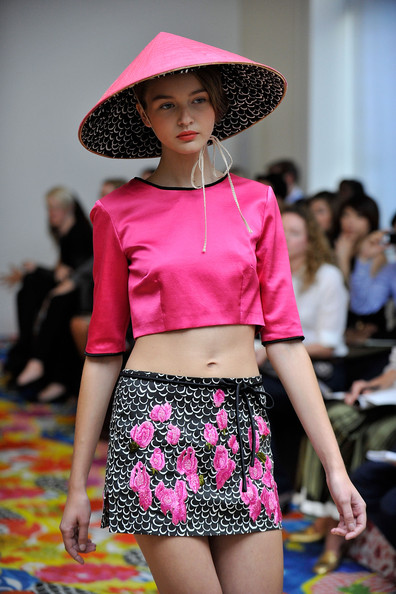 Hyphen Magazine published an incredible piece by Catherine Traywick called “The Beautiful Generation: Asian Americans and the Cultural Economy of Fashion” (February 25, 2011) that analyzes Asian cultural influences in the global fashion industry by comparing it to the emergence of Asian American designers. Traywick’s piece brought up thoughtful points, contrasting Anglo-Euro conceptions of the “Asian exotic chic” trope with a new one: the emergence of Asian American designers in the industry. This emergence of Asian Americans does not in itself mean progress, however. Without active measures taken by APA designers, we too, like the conical hat pictured from Philosophy Di Alberta’s Spring ’11 collection, will become a commodifiable cliche.
Hyphen Magazine published an incredible piece by Catherine Traywick called “The Beautiful Generation: Asian Americans and the Cultural Economy of Fashion” (February 25, 2011) that analyzes Asian cultural influences in the global fashion industry by comparing it to the emergence of Asian American designers. Traywick’s piece brought up thoughtful points, contrasting Anglo-Euro conceptions of the “Asian exotic chic” trope with a new one: the emergence of Asian American designers in the industry. This emergence of Asian Americans does not in itself mean progress, however. Without active measures taken by APA designers, we too, like the conical hat pictured from Philosophy Di Alberta’s Spring ’11 collection, will become a commodifiable cliche.
Western designers have long since lifted elements of Asian culture to infuse into their collections, though they have rarely done it well (and yet such orientalist designs are lauded by mainstream fashion critics as “special, unique, interesting,” as I will address later in this post). In fact, the results can come out quite miserable, and borderline racist. Take for instance the 2010 controversy over Christian Dior’s “Shanghai Dreamers” ad campaign, which was unabashedly inspired by imperialism and Rudyard Kipling’s “White Man’s Burden.” Quentin Shih, a Chinese American photographer, conceived of the idea and collaborated with Dior for the campaign. Shih’s involvement either makes the below images okay (which seems to be the defense taken up by the Dior camp) or it adds a doubly juicy element, one of internalized self-hate and love-for-master colonialist tendencies. You decide.
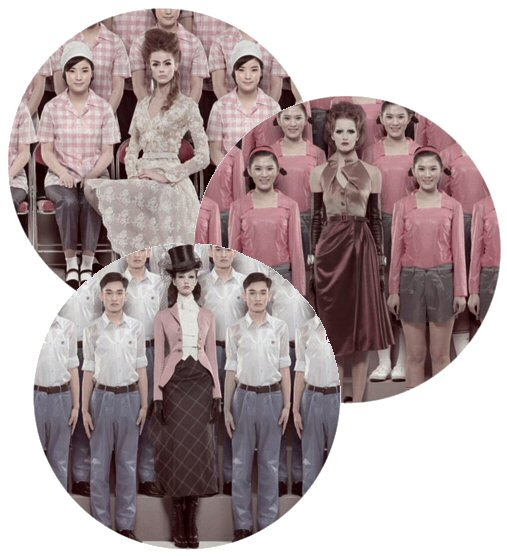
And if you somehow missed that whole Dior fiasco (notwithstanding the Galliano one when he sputtered anti-Semitic epithets…oh Dior, Dior, thou giveths the devil his due), read more commentary about the “Shanghai Dreamers” campaign from Jenny Z. of Fashion For Writers, Madeleine O’Dea of ArtInfo China, or Tom Lasseter of China Rises. Lasseter’s piece features a statement from Shih about his conception of “Shanghai Dreamers.” For more image spreads from the ad campaign, see the gallery at Trendland.com.
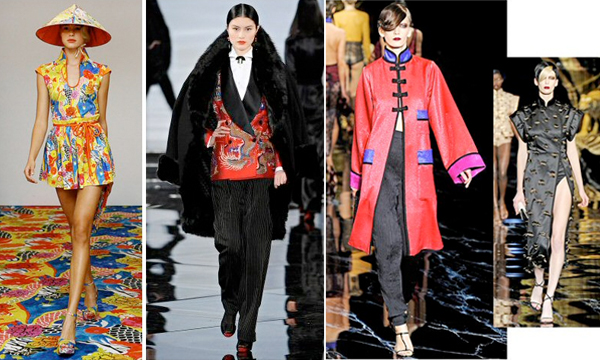 2011 has been a garish potpourri of the Asian trope, from Alberta Ferretti, Ralph Lauren, and Louis Vuitton to slightly more tasteful executions by Pamella Roland and Carolina Herrera. Herrera, unlike the other designers who stuck around “exotic glorified Chinese prostitute chic” and “hyper-sexed peasant girl in rice paddy hats,” seized her inspiration from Korea to create a halfway decent collection. Roland and Herrera offer stunning pieces this season using the Asian trope. With that said, it is still a trope, and disappointing to see such titanic figures in the industry relying on cliches.
2011 has been a garish potpourri of the Asian trope, from Alberta Ferretti, Ralph Lauren, and Louis Vuitton to slightly more tasteful executions by Pamella Roland and Carolina Herrera. Herrera, unlike the other designers who stuck around “exotic glorified Chinese prostitute chic” and “hyper-sexed peasant girl in rice paddy hats,” seized her inspiration from Korea to create a halfway decent collection. Roland and Herrera offer stunning pieces this season using the Asian trope. With that said, it is still a trope, and disappointing to see such titanic figures in the industry relying on cliches.
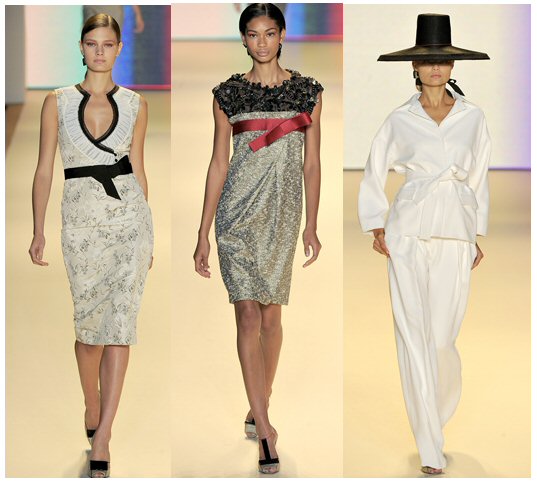
The latter half of Traywick’s article compared the Asian trope with the rise of Asian American designers in the industry. Indeed, the American fashion industry has had its eye on Asian American designers for some time now. A 2009 Wall Street Journal article by Ray Smith covered this rise, citing the likes of Thakoon, Doo.Ri, Phillip Lim, Alexander Wang, and Peter Som, among others. Smith attributed this rise to a “cultural shift…that has liberated [Asian Americans] from traditional career expectations.”
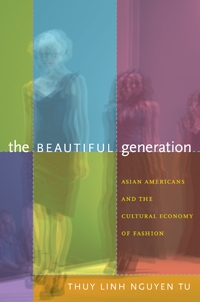
This observation is different from that of Traywick’s and Nguyen Tu’s, author of The Beautiful Generation (Duke University Press 2010), on which Traywick’s article was based. The expectation of immigrant Asian parents that their children will pursue careers in law and medicine is still strong, and presents another obstacle that Asian American designers have to overcome. The majority of APA designers that Tu interviewed did not go to design school; they went to dental school. APA designers seem to pursue, at least initially, the traditional career paths expected of them, entering finance, law, majoring in biology and anthropology, etc. before circling back to their passion for art and design.
Smith’s article was then piggybacked by Eric Wilson’s 2010 New York Times piece that noted the prevalence of Asian American designers at the American Fashion Awards and the increase in enrollment of Asian Americans in fashion design schools. Wilson compared this trend to that found in the Jewish American community where first generation immigrants worked in the garment district and in apparel factories, paving the way for second generation Jewish American designers, like Calvin Klein, Donna Karan, Marc Jacobs, and Michael Kors.
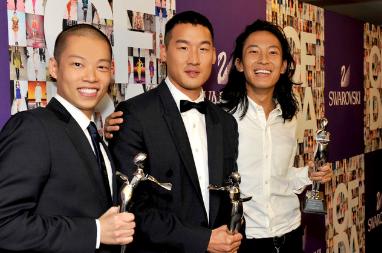
Here Nguyen Tu notes the same path among Asian Americans: first generation Asian immigrants worked as low-wage sewers, cutters, and pattern makers, then passed their knowledge on to the second generation children, e.g., Derek Lam, and DooRi Chung, who then came to dominate as creative pioneers in the fashion industry. Thus, while their seamstress and garment factory worker parents pushed APA designers toward traditional career paths, it is, incidentally, their parents’ skill sets and close ties to garment manufacturing that propelled APA designers to industry success.
However, this rarely means more Asian American representation among the models that designers use. Unfortunately. The draw is still in the exoticism of the Asian trope, but not actually in Asian Americans as artists and role models. When Anglo-Euro designers use the trope, they select the–do forgive the crude descriptive here–chinkiest Asian models they can find to stuff into their cheongsams and kimonos. Meanwhile the Asian American designers seem to avoid Asian models entirely.
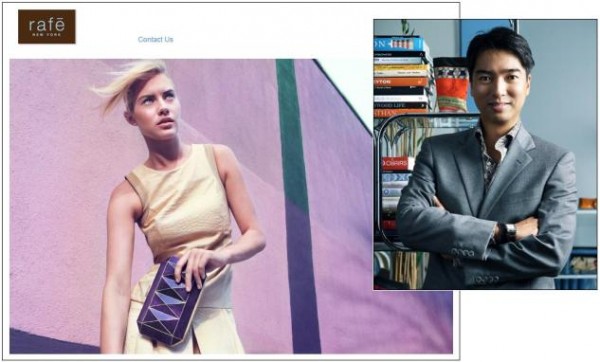
As of this writing, current cover models for APA designers 3.1 Phillip Lim; Alexander Wang; Doo.Ri NYC; Peter Som; Derek Lam; Rhys Dwfen (below); Rafe New York (above); even Project Runway APAs, Chloe Dao; Diana Eng; Jerry Tam; Ivy Higa; or my personal favorite, Andy South, are all or almost all white. (Although, Jason Wu, thank you for using one Asian model. And Vera Wang, as always, you rock.)
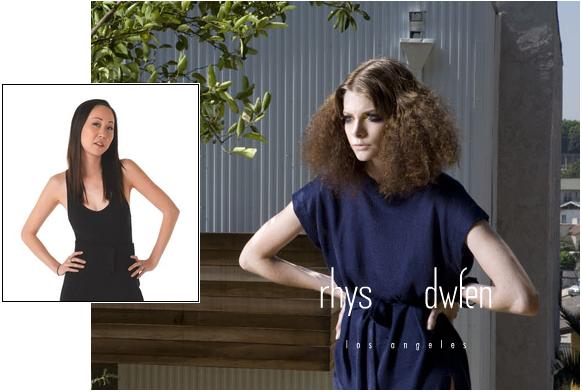
Now, what I find most interesting, which none of the above cited literature discussed, is the matter of APA designers picking up on the Asian trope where the Anglo-Euro ones leave off, plus how (and why) Asian Americans execute the Asian trope. Katherine Kwei, an accessories designer who takes cues from traditional Chinese arts such as Chinese knotting to incorporate into the design of her handbags, has gained international recognition and acclaim for her fusion of East and West. Mei Vintage by designer Alice Huang, a line of eco-friendly handbags made from old kimonos, also pays homage to the designer’s ethnic roots. Speaking of “East meets West” and “paying homage to ethnic roots,” these are the descriptions that often accompany APA designers who go this route, along with the words “tradition,” “modern,” fusions of “tradition and modern,” and “rich cultural story.” Vivienne Tam rose to fame due in great part to her mix of “traditional and modern” concepts, and by traditional of course, we mean Asian.

Many of us APAs grow up in households that instill a strong reverence for the place our parents or grandparents come from, and fashion design becomes an extension and expression of that strong reverence. I appreciate the homage, but as Traywick noted, there is still much progress that needs to be made for APA fashion designers. Pride in one’s Asian heritage is absolutely what I love to see and Katherine Kwei, Alice Huang, and Vivienne Tam are among my favorite designers, but pride in one’s Asian heritage is not the same as expressing an APA-activist point of view.
To prevent the emergence of APA designers from becoming a mere trope, one that objectifies the designers themselves and belittles their creative work, APA designers need to engage in some good old fashioned all-American political activism. Fashion has always been integrally tied in with politics. During times of war, such as the recent events in the Middle East, military styles come into trend. Hemlines of skirts, even the issue of pants versus skirts have consistently followed trends in the feminist movement.
With the Asian trope gone rampant in 2011 collections, Anglo-Euro designers have stated the use of “oriental styles” as a political comment on the recent rise of China to global power. Traywick’s article references many fashion critics who discuss this at length. However, when Asian American designers use the Asian trope, it’s viewed as ethnic, not political. Anglo-Euros using the Asian trope is “special, unique, interesting” and, even better, creative political commentaries on the state of the world. On the other hand, Asian Americans using the same trope is “well, it’s their culture; it’s what they know; it’s to be expected.” Asian American fashion designers are not seen as political activists or pioneers, and perhaps that’s the problem.
Negative criticisms of APA designers often imply a lack of creativity or innovation (recalling the stereotype that Asians are all robots), most notably on Project Runway when the judges referred to designer Ivy Higa as a mere seamstress (“She’s a seamstress. That’s all,” said Michael Kors) and not a “real” designer, a moment that really got my blood boiling, or the critiques comparing Asian American designers to Asian designers, rather than other American designers. Thus Traywick concluded that APA designers still fall somewhere “between artist and producer,” snubbed by mainstream fashion critics as manufacturers and “very good seamstresses,” and between “American and foreigner.”
To transcend that will take activism. APA designers need to challenge themselves and their creativity beyond homages to their cultural heritage and ethnic roots. They cannot regurgitate Asian tropes. That said, they also cannot turn their backs on identity politics, which many APA designers do out of fear of being typecast (a valid fear, by the way, because oftentimes that is exactly what happens).
APA designers need to take a bold stand on their political identities and express that through their art and design. I haven’t seen many APA designers reconciling politics and art. Rather, it’s been either a straightforward “East meets West, traditional plus modern” deal or the other extreme, where they sidestep their heritage and Asian American identity altogether to concentrate entirely on art. But what makes art relevant is its political significance, as we see time and time again in the most glorified artists and works of art in history. It is, in fact, an APA artist’s unabashed sociopolitical stand that will cause him or her to be seen as a legitimate American artist, and, as applied to the realm of fashion design, not merely a “good seamstress” or something between “American and foreigner.”
Hat Tip: Iris Law of Lantern Review.
[Photo credits: Zimbio, Trendland, New York Magazine, Vogue, Style.com, NY Times]








